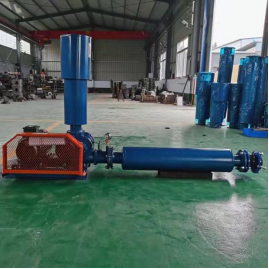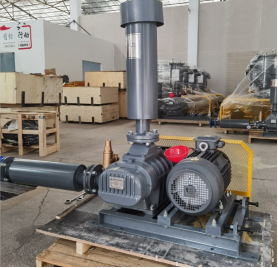The introduction of Roots blower
The Roots blower is a volumetric blower, with the end face of the impeller and the front and rear end covers of the blower. The principle is a rotary compressor that uses two leaf-shaped rotors to move relative to each other in the cylinder to compress and deliver gas. This type of blower has a simple structure and is easy to manufacture. It is widely used in aquaculture aeration, sewage treatment aeration, and cement transportation. It is more suitable for gas transportation and pressurization systems in low-pressure situations, and can also be used as a vacuum pump.
I. Composition
1. Roots blower is composed of five parts: casing, wall panel, impeller, oil tank and muffler.
2. Chassis: It mainly plays the role of support (wallboard, impeller, muffler) and fixation.
3. Wallboard: mainly used to connect the casing and the impeller, support the rotation of the impeller, and play the role of end face sealing.
4. Impeller: It is the rotating part of the Roots blower, which is divided into two leaves and three leaves. However, the three leaves have gradually replaced the two leaves Roots blower due to many advantages such as smaller air outlet pulsation, lower noise, and more stable operation than the two leaves. .
5. Oil tank: mainly used to store lubricating oil for lubricating gears and bearings.
6. Muffler: It is used to reduce the noise generated by the pulsation of the air flow when the Roots blower enters and exits.
II. working principle
Roots blower is a kind of volumetric blower. There are two three-blade impellers that rotate relatively in the space sealed by the casing and wall panels. Since each impeller adopts the envelope of involute or epicycloid Line, the three blades of each impeller are identical, and the two impellers are also identical, which greatly reduces the difficulty of processing. Numerical control equipment is used in the processing of the impeller to ensure that the center distance of the two impellers remains unchanged, no matter what position the two impellers rotate to, a certain minimum gap can be maintained, so as to ensure that the gas leakage is within the allowable range.
The two impellers rotate in opposite directions. Due to the extremely small gaps between the impeller and the impeller, the impeller and the casing, and the impeller and the wallboard, the air inlet forms a vacuum state, and the air enters the air inlet chamber under the action of atmospheric pressure. Then, Two of the blades of each impeller form a sealed cavity with the wallboard and the casing. The air in the intake cavity is continuously brought to the exhaust cavity by the sealed cavity formed by the two blades during the rotation of the impeller. The impellers in the air cavity are meshed with each other, so that the air between the two blades is squeezed out. In this continuous operation, the air is continuously transported from the inlet to the outlet. This is the Roots blower. the whole working process.
III. Advantages
Due to the adoption of the three-blade rotor structure and the reasonable structure of the air inlet and outlet in the casing, the fan has small vibration and low noise.
The impeller and shaft are of integral structure and the impeller has no wear, so the performance of the fan remains unchanged for a long time and can run continuously for a long time.
The volume utilization rate of the fan is large, the volume efficiency is high, and the structure is compact, and the installation method is flexible and changeable.
Complete range of models can meet the needs of different users for different purposes.



